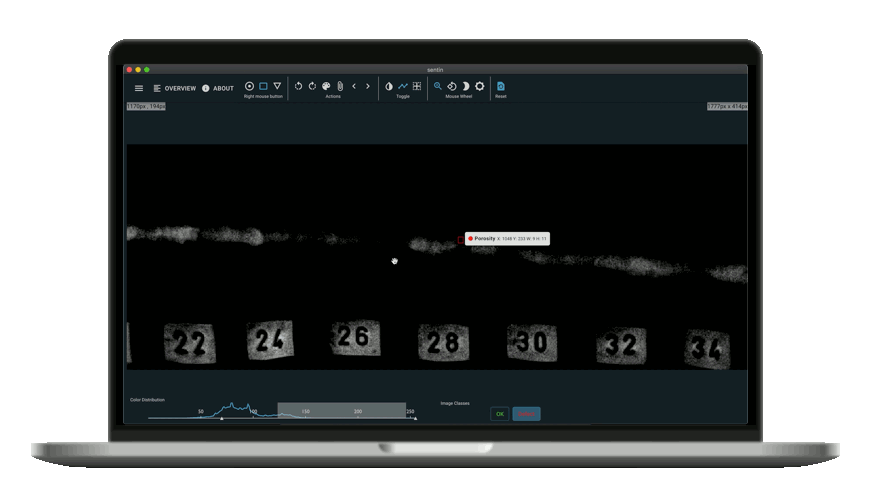There’s a remarkable interaction between the fourth revolution in non-destructive evaluation (NDE 4.0) and fourth industrial revolution (Industry 4.0). In the process, NDE 4.0 benefits from Industry 4.0 and Industry 4.0 benefits from NDE 4.0.
Table of Contents
This article is part of a summary series of Dr. Johannes Vrana‘s & Ripi Singh‘s publication “The NDE 4.0: Key Challenges, Use Cases, and Adaption”. Their research deals with the latest methods of NDT. Their consulting company is a competent partner for research & development in the field of NDT.
Here are the other parts of our series about NDE 4.0:
Benefits: Industry For NDE 4.0
The methods and technologies established in Industry 4.0 can be beneficial for NDE. Those are mainly:
- NDT Method Enhancement
- Equipment Improvement
- Improved Control & Traceability

NDT Method Enhancement
Industry 4.0, or the fourth industrial revolution, is adopting a wide array of emerging technologies that enhance the current NDE methods, resulting in NDE 4.0. Cloud Computing and Storage, Artificial Intelligence, Robotics, Big Data, Blockchains as well as augmented realities are among the emerging technologies being used in the fourth industrial revolution. So, without Industry 4.0, NDE would remain stagnant, and NDE 4.0 would never come to existence.
Equipment Improvement
NDE 4.0 is a product of the improvement of NDE equipment. The improvements done on the NDE/NDT equipment depend on the user behaviors and user feedback on the equipment. The feedback could be in the form of error codes, software errors and system status information generated by the equipment while in use. By providing such data to equipment manufacturers, they (the manufacturers) could use the resulting information to improve their non-destructive evaluation equipment, systems and software through statistic data evaluation. When it comes to user behaviors, they might be useful in the improvement of the usability of the equipment.
Improved Control & Traceability
Another aspect of Industry 4.0 for NDE 4.0 pertains various aspects of controlling the inspections. There are various measures and standards that have to be taken in consideration when an inspection is being done. For instance, component traceability, which established if the inspection was done on the right component. The implementation of revision-safe data storage might be necessary. This can be achieved through blockchain use and by use of digital component files and the identifiers of electronic components for component identification.
Additionally, IIoT technologies and interfaces support digital workflow by allowing electronic transfer of job descriptions. The interfaces also facilitate the improvement of digital commissioning by enabling the transfer of the order-related information.
The results of the statistics generated and destructive test feedback loop, service inspection results and the testing of End Of Life components assist quality assurance experts, including NDE inspectors, to be more accurate when establishing the value and reliability of an inspection.
Generally, inspection control helps in ascertaining and getting a clearer picture of the value of NDE 4.0 and NDT 4.0.
Benefits: NDE 4.0 For Industry
The NDE 4.0 technology can also be beneficial for the industry. The main advantages are:
- Easier Data Transfer
- Better Data Evaluation
- Production Process Improvement

Easier Data Transfer
The cases concerning the application of NDE in Industry 4.0 begin with data transfer that follows the standardized interfaces of Industry 4.0. once the transfer is successful, the data can then be stored in digital twins, clouds or data-base systems.
The data is transferred using standard interfaces. NDT 4.0 also makes it possible to get direct feedback during in-situ inspections in manufacturing or operation processes using ultrasonic or optical sensors. This helps computer systems to understand the relevant data better.
Better Data Evaluation
The NDE 4.0-powered digital understanding of data is a valuable asset with a wide range of possible application in Industry 4.0. Some of the possible uses of the asset include production and design feedback loops, probabilistic lifing methods for more accurate component life calculations, predictive maintenance and reliability engineering.
Production Process Improvement
The inspection of additive manufacturing components is usually quite challenging because of the complexity of the internal structures and shapes of these components. Mostly, it’s only computed tomography that works, of all the traditional NDT methods. Fortunately, NDE 4.0 provides a solution to this.
With the emerging optical sensors, it is possible to monitor and record the infrared, visual or even ultraviolet light and generate feedback loops very easily. The data generated it is possible to measure the internal as well as the external dimensions of the components. Monitoring and correcting heating and cooling, expansion and shrinking as well as melting and freezing processes becomes possible too.
How can I use NDT 4.0 today?
We are helping companies, organizations and individual inspectors carry out non-destructive tests on their machine parts, pipelines, power plants and airplanes, among other crucial mechanical systems, units and parts accurately. The sentin EXPLORER simplifies the evaluation of images by automatically analyzing and marking imperfections and improving the image quality.
Here are the other parts of our series about NDE 4.0:






